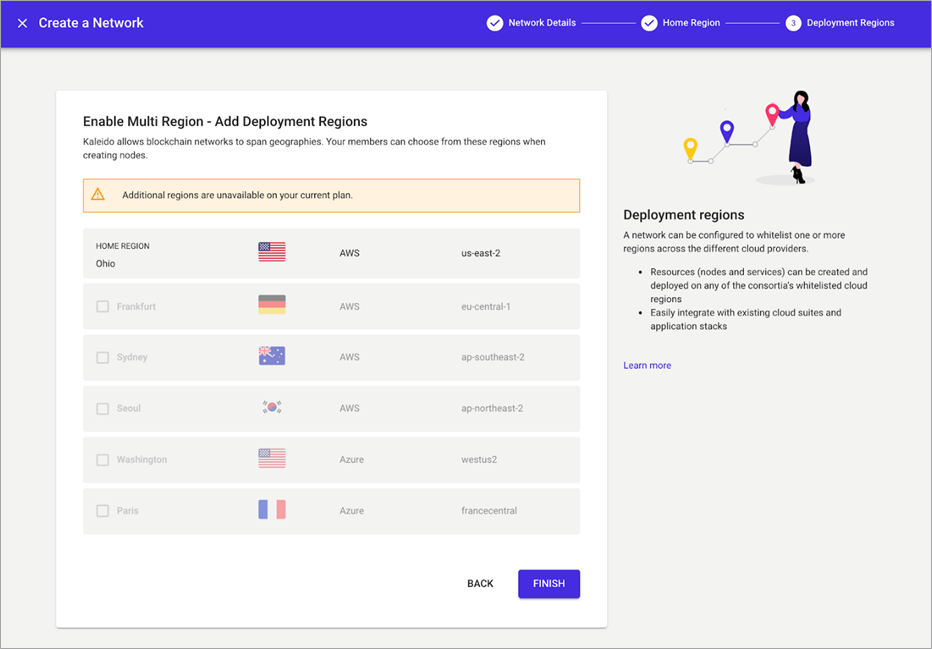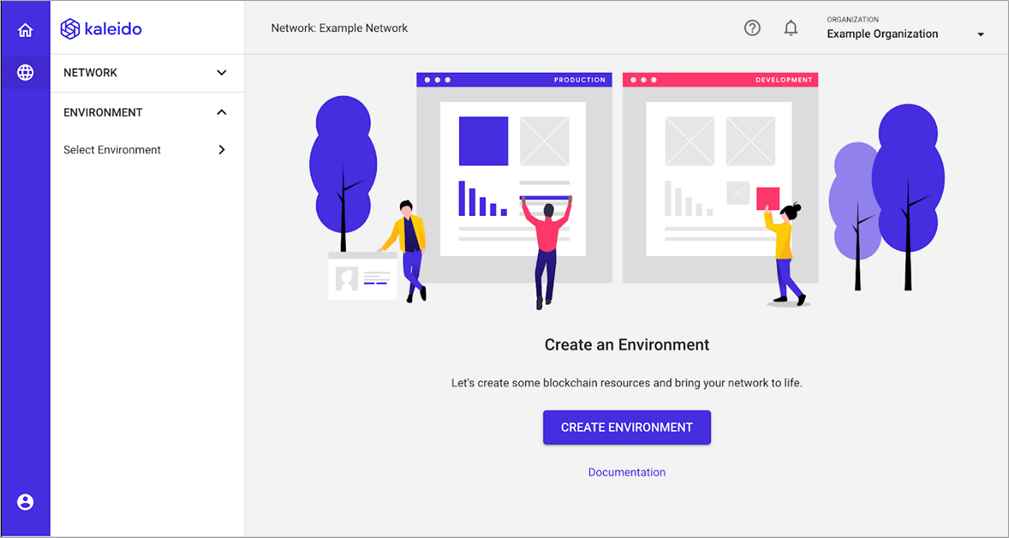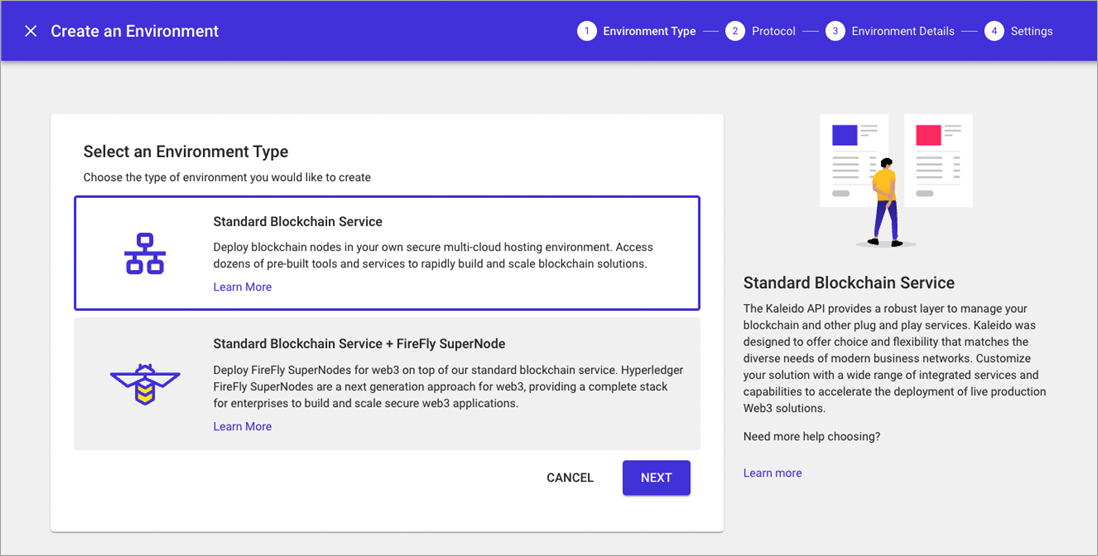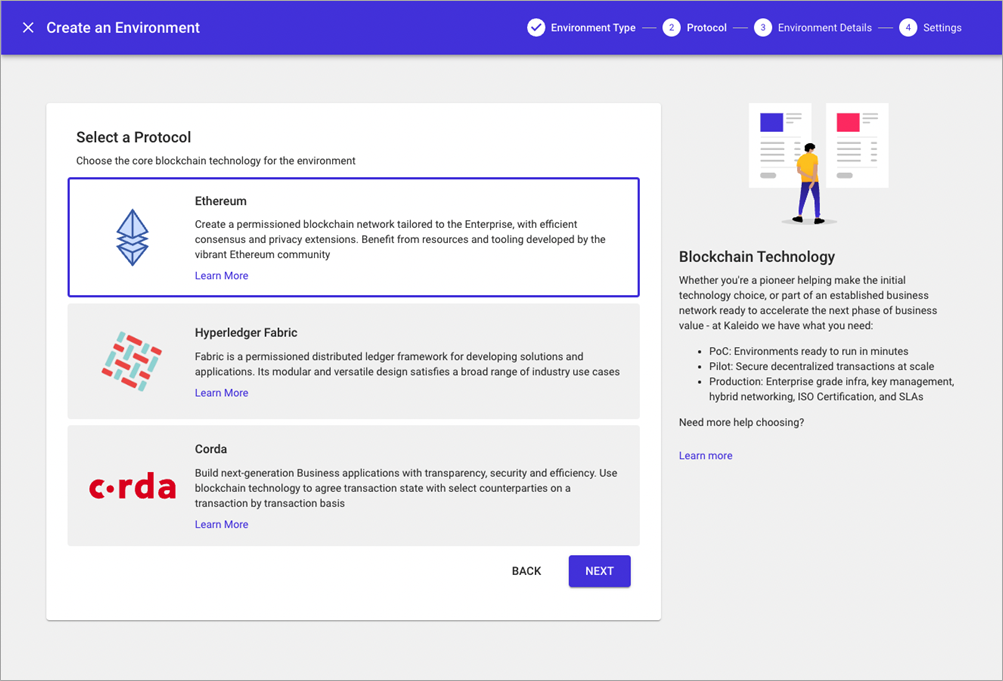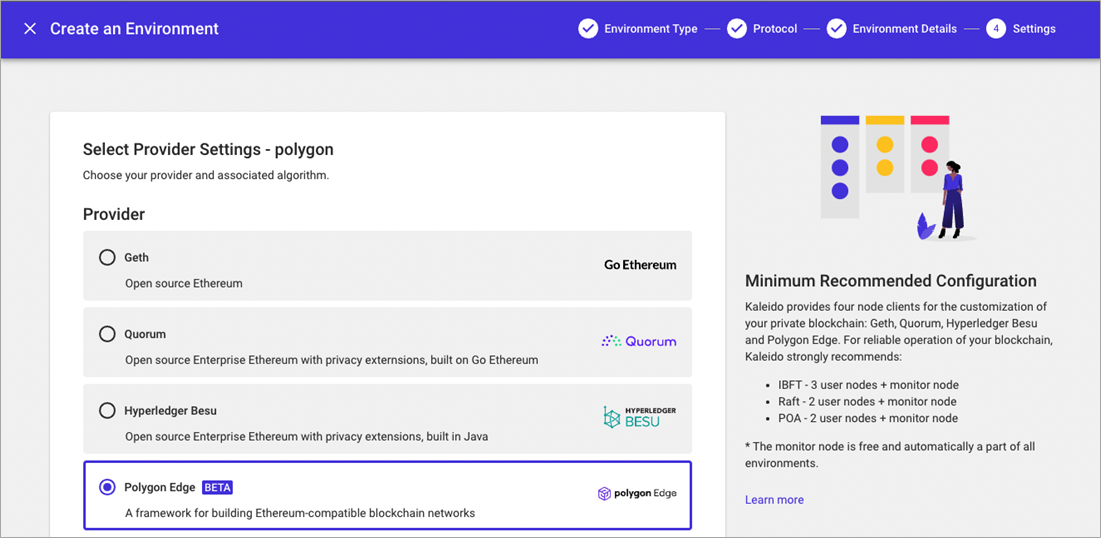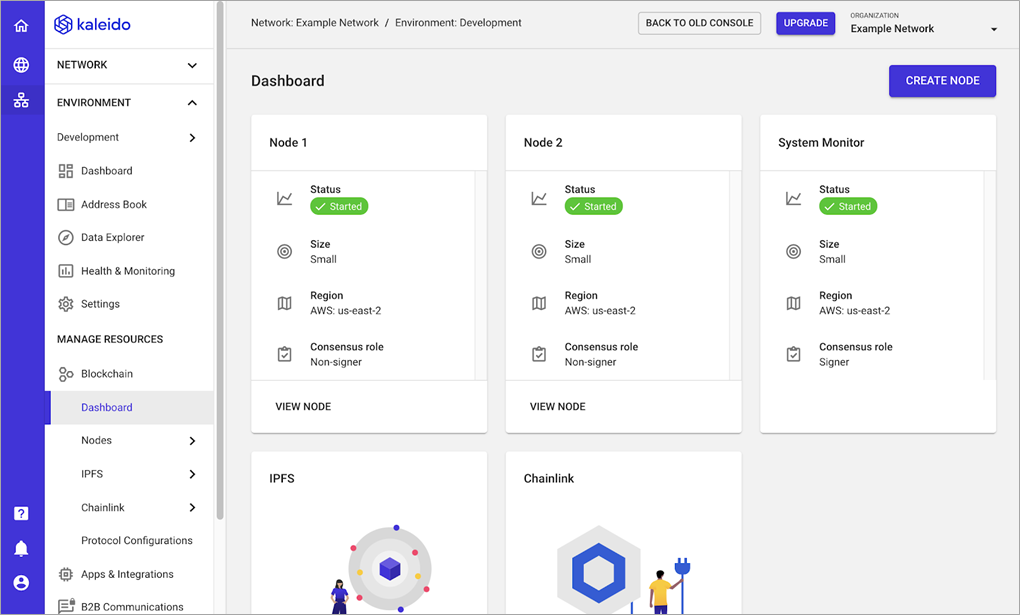AWS Partner Network (APN) Blog
How to Run a Polygon Edge Chain on AWS with Kaleido
By Nick Gaski, Solutions Architect – Kaleido
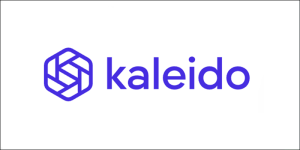 |
| Kaleido |
 |
Kaleido is an AWS Partner and enterprise-grade software-as-a-service (SaaS) platform that makes blockchain applications and digital assets radically simple for businesses of all kinds.
Available on AWS Marketplace, developers can use Kaleido to build multi-region, multi-cloud blockchain networks on protocols both public and private, all of which offer support for Hyperledger FireFly Supernodes, the complete stack for Web3 development.
With the security, compliance, and scalability necessary for even the most regulated industries, Kaleido is a platform of choice for both startups and global enterprises. It is ISO27K and SOC 2 Type 2 certified with built-in high availability and disaster recovery.
In this post, I will talk specifically about how Kaleido’s pre-built services and APIs work atop the Polygon Edge protocol to help developers reach production faster. I will also show how you can launch a Polygon Edge chain on the Kaleido platform in minutes.
Why Polygon Edge?
Traditionally, enterprises created private blockchains to control data and keep operating costs low. These private networks were secure and faster than mainnet applications.
However, as the blockchain ecosystem expanded, enterprises came to value the transparency that public networks offered. They also saw emerging marketplaces in decentralized finance (DeFi) and non-fungible tokens (NFTs) that offered new revenue potential.
Polygon is an Ethereum-based blockchain that allows users to scale transactions with much smaller fees than the Ethereum mainnet. As Polygon grew, it added scaling solutions, including Polygon Edge, which is usually used to create a blockchain for a specific application that can then connect to the Polygon mainnet or work with other scaling solutions.
Additional advantages that come with building applications on Polygon Edge include:
- Access to Polygon technology: Building your application on Polygon Edge opens you up to access the full suite of Polygon scaling solutions.
- Algorithmic flexibility: Polygon Edge supports both proof of authority and proof of stake.
- Zero-gas transactions: You can build your business application and never have to worry about paying gas fees for transactions.
Scaling solutions like Polygon Edge give enterprises a way to build the dedicated, sovereign chains they are accustomed to with the added advantage of being able to plug into public networks.
Polygon Edge on Kaleido
On the Kaleido platform, Polygon Edge becomes a modular framework for bootstrapping Ethereum-compatible networks. This means developers can tailor the application to their business needs and later access the broader world of Web3.
When you build with Polygon Edge on Kaleido, you get the latest version of Polygon Edge with regular updates for new features, out-of-the-box proof of authority (PoA) consensus support, and the ability to easily deploy your own smart contracts with Kaleido’s Smart Contract Management system.
Running Polygon Edge on Kaleido allows developers to leverage Kaleido’s no-code token templates (based on the battle-hardened OpenZeppelin libraries) to mint, transfer, and manage ERC20, ERC721, or ERC 1155 tokens, as well as monitor transactions via a built-in data explorer.
Kaleido offers instant, secure, and dynamic hosting solutions on AWS. It also lets developers stand up a global development footprint with high availability and disaster recovery infrastructure, dedicated 24×7 support from blockchain experts, and enterprise-grade compliance.
Using Kaleido to build an application on Polygon Edge allows enterprises to create a bespoke application with the right mix of scalability, security, cost, and openness.
From financial service applications that need to produce and maintain custody of thousands of digital assets, to supply chain applications looking to digitize paperwork, to data marketplaces in the healthcare space—any application that needs to facilitate a high volume of transactions is a candidate for Edge. Kaleido’s platform makes it simple to create these token ecosystems with a series of no-code templates.
Let’s walk through how you can build a blockchain network powered by Polygon Edge on the Kaleido platform.
Launch Polygon Edge on Kaleido in Minutes
Once you set up an account on Kaleido, you can start to build your first business network and use Polygon Edge as your underlying blockchain.
Step 1: Create a Business Network
Visit https://console.kaleido.io and enter your organizational email and password to login. Click the Create Network button in the middle of the page and you will be prompted to name your business network and define your business network.
After you click Next, you’ll be prompted to select a cloud provider. This is where you can choose to host your Polygon Edge chain on AWS.
Figure 1 – Choose from popular deployment options and geographic regions.
Once you click Finish your business network is ready. At this point, it’s a namespace with an underlying home region, a name, and your Kaleido organization existing as the sole membership.
Next, click the Create Environment button to generate your first blockchain namespace. An environment in Kaleido is an isolated domain with nodes, services, and security credentials confined solely to it. Each environment is its own unique blockchain.
Figure 2 – Select protocols, consensus mechanisms, and pre-built services and APIs.
Step 2: Choose an Environment Type
Kaleido offers two top-level environment types: a Standard Blockchain Service and the Standard Blockchain Service backed by Hyperledger FireFly Supernodes. Choose the Standard Blockchain Service tile and then click Next.
Figure 3 – Kaleido offers standard blockchain services and environments backed by Hyperledger FireFly.
The Standard Blockchain Service orchestration supports three protocol choices: Enterprise Ethereum variants (Polygon, Geth, Quorum, and Besu), Corda, and Hyperledger Fabric.
To find Polygon Edge, choose the Ethereum tile and click Next.
Figure 4 – Kaleido makes it easy for developers to build on their protocol of choice.
Provide a name for your environment (such as Development) and click Next. Note that the Deployment Region is automatically inherited from your business network configuration.
Step 3: Create a Polygon Environment
Choose the protocol settings for your environment. You can choose between four node clients (Geth, Quorum, Hyperledger Besu, and Polygon Edge) and their supported consensus algorithms.
Select Polygon Edger and click Finish to provision your environmental namespace.
Figure 5 – Kaleido offers support for enterprise chains and scaling solutions like Polygon Edge.
Step 4: Deploy Nodes to Your Polygon Environment
Now that the environment has been created, you can add a blockchain node. A node will allow you to deploy smart contracts and perform meaningful chain-layer interactions. Polygon nodes are the core runtimes responsible for transaction execution and consensus.
By following the prompts on screen, you’ll be able to create and name your first node. Next, depending on your plan level, you’ll be able to set the size and role of your node. You’ll follow the same steps to add a second node.
Different consensus algorithms require a different number of nodes to maintain consensus, and for Polygon Edge networks running proof of authority, I recommend deploying at least two user nodes and a monitor node.
Once you’ve created the correct number of nodes, you can return to the Dashboard to check the status of your nodes. When the resources are green and have a state of Started, they are ready for use.
Figure 6 – Get full visibility into nodes, runtime, activity logs, and utilization.
Step 5: Start Building Your App
You’ve now successfully deployed your Polygon Edge blockchain network. Now that you’re up and running, it’s time to start building your app.
From here, you have many options: if you already have a smart contract for your app, you can deploy it via Kaleido’s Smart Contract Management tools.
If you don’t have a smart contract yet, Kaleido has a rich library of functionality around tokens and digital assets, including no-code token templates so you can easily deploy your own ERC-20 or ERC-721 smart contract just by defining the orchestration and the configuration that you want.
All of the code and compilers you need to easily mint and manage tokens are provided in the Kaleido Token Factory.
Conclusion
The worlds of permissioned and public blockchains are converging, as enterprises look to realize some of the transparency and market opportunities defined in the public space.
Using Polygon Edge on the Kaleido platform as the underlying blockchain layer in your application sets you up to build a high throughput application that has the ability to plug into the mainnet at will.
To try out Kaleido for yourself, open an account for free. The starter plan allows you to launch a Polygon Edge chain in minutes. If you have questions about how Kaleido and Polygon Edge can help you reach your business goals, just get in touch with the team at Kaleido.
The content and opinions in this blog are those of the third-party author and AWS is not responsible for the content or accuracy of this post.
Kaleido – AWS Partner Spotlight
Kaleido is an AWS Partner and enterprise-grade SaaS platform that makes blockchain applications and digital assets radically simple for businesses of all kinds.
